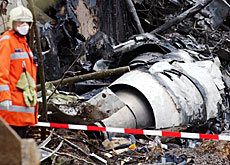Satellites offer hope of safer skies

A Swiss engineer has invented a new aeroplane navigation and flight control system, which he says will improve safety and cut the number of accidents.
The system, which has taken 15 years and millions of Swiss francs to develop, works by replacing all the cockpit instruments with just one device.
The Global Integrated Air Navigation System (Gians) is the brainchild of Zurich-based research engineer Kurt Tschannen.
“There are too many instruments [in aircraft cockpits]… pilots have to interpret these and sometimes this leads to errors and very serious accidents,” Tschannen told swissinfo.
“The Alitalia crash at Stadlerberg is one example and so is the Crossair accident in Bassersdorf,” he added.
Both of the accidents in question – Alitalia in 1990 and Crossair in 2000 – were blamed on pilot error. Forty-six people were killed when the Alitalia DC-9 crashed, and ten died on the Crossair Saab 340.
Tschannen, a pilot himself, says these and many other accidents have highlighted the need for simpler aircraft navigation systems.
At one glance
There are on average more than 50 instruments in the cockpit of a commercial plane. With Gians, these would be integrated into one onboard computer with a dual display of key navigation and flight data.
“A pilot would have complete awareness of the situation at one glance,” said Tschannen. “All the information would be presented in a simple and easy-to-manage manner.”
The high-tech system includes three databases: one for navigation data, one for charts – to replace the paper versions currently used in cockpits – and one for terrain which uses 3D pictures.
This gives the pilot a perfect view of the surrounding landscape, even in bad weather.
An onscreen 3D tunnel guidance approach leads the pilot to the runway, making landings safer.
Tschannen says this would help with approaches to Zurich airport, which has noise restrictions, and help pilots navigate the high terrain around Lugano airport.
“These problems can be solved quickly and easily since we can make curved approaches to any runway at airports which are surrounded by noise sensitive areas, high terrain or even nuclear power stations,” said Tschannen.
Sophisticated
Gians uses the Global Positioning System (GPS) – a satellite-based navigation and location system – to give pilots precise information about their position.
Other navigation systems exist, but Tschannen’s is the first to use a digitally generated environment to guide the pilot.
Tschannen says that test flights using the system have all been very successful, even in difficult conditions.
The system is currently undergoing an international approval process – a requirement for new aviation technology – which will last up to 18 months. But the engineer is hoping that it will be snapped up by the industry, if and when it is approved.
“We have had a positive response to Gians,” Tschannen told swissinfo. The airline operators and the authorities think that it represents the future in air navigation, and we are in contact with airlines and aircraft manufacturers as well.”
Aware
The Federal Office for Civil Aviation has expressed interest in Gians, but stresses that the system has still to be fully tested.
“The system is an interesting approach for the use of future navigation technology but it is not ready to be used in aircraft yet,” the office’s Daniel Göring told swissinfo.
Gians has so far cost millions of Swiss francs to develop and Tschannen urgently needs SFr2.5 million ($2 million) more for the international approval process.
He says that he regrets that he didn’t receive more support from the government or the banks for his invention, adding that more help for the high-tech industry would benefit the Swiss economy.
However, Tschannen is confident that Gians’s focus on safer flying will ensure that it has a bright future.
“It represents a tremendous increase in safety for commercial aircraft and other planes, and that is the main aim – to prevent accidents,” he said.
swissinfo, Isobel Leybold-Johnson
The Global Integrated Air Navigation System (Gians) was invented by Swiss engineer, Kurt Tschannen.
It aims to replace the many cockpit instruments with just one device to improve safety and reduce the number of crashes.
Gians is currently in its testing phase and needs SFr2.5 million to continue its development.

In compliance with the JTI standards
More: SWI swissinfo.ch certified by the Journalism Trust Initiative












You can find an overview of ongoing debates with our journalists here . Please join us!
If you want to start a conversation about a topic raised in this article or want to report factual errors, email us at english@swissinfo.ch.